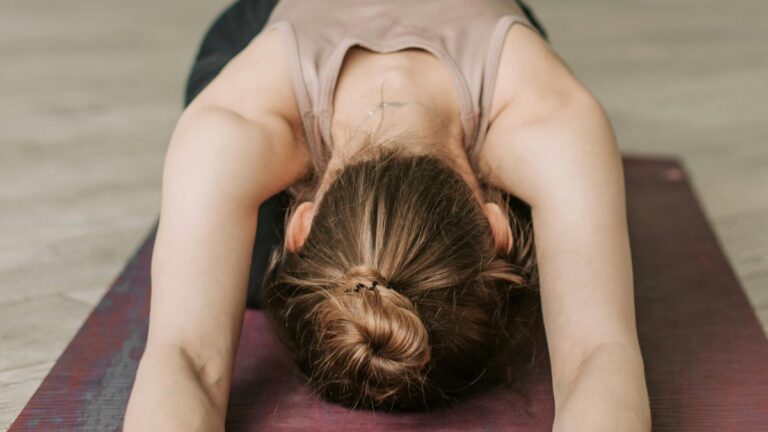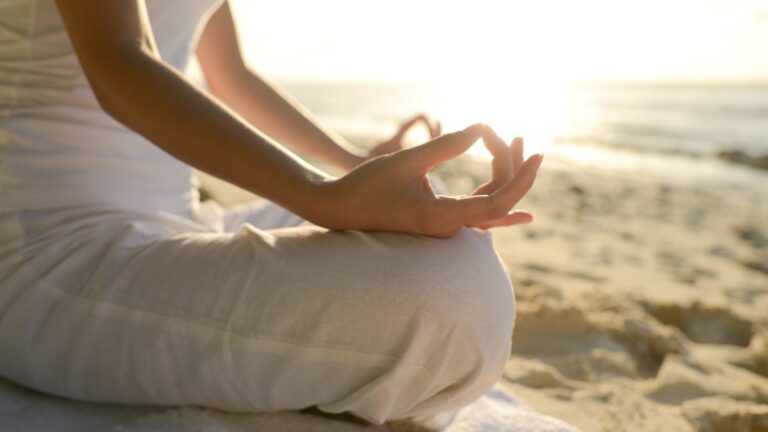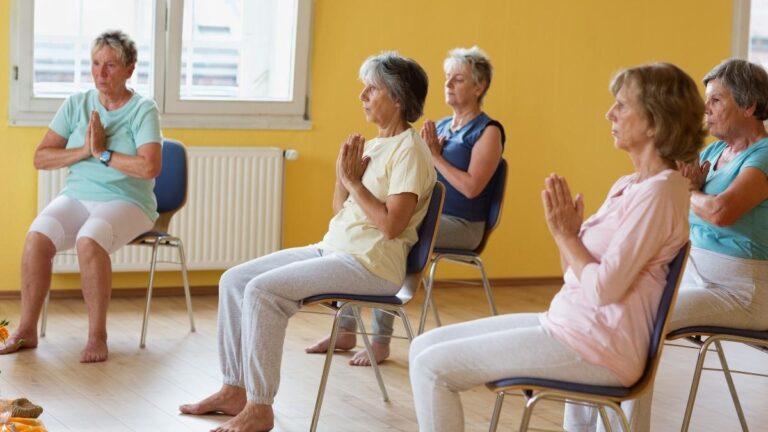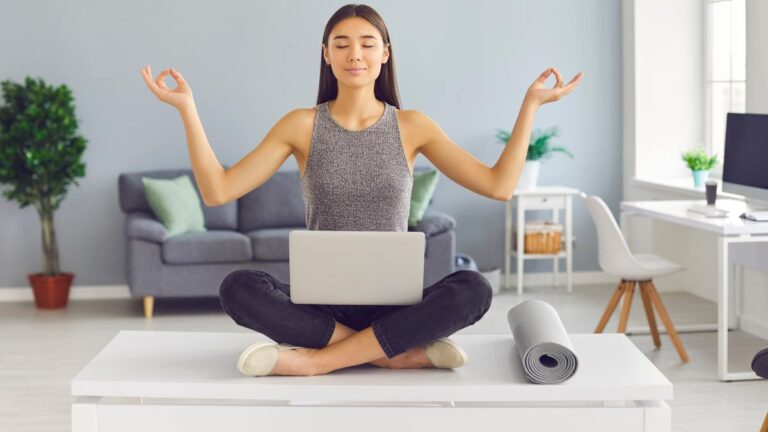Chair Pilates For Seniors – Gentle Routines To Stay Active!

Last Updated on June 25, 2025
What if your next best workout only required a chair—and the willingness to try something new? Aging doesn’t mean slowing down; it means getting smarter about how we move.
Chair Pilates for seniors, and in general, offers a fun, surprisingly effective way to build strength, improve flexibility, and boost confidence—all while sitting down.
Whether you’re recovering from surgery, managing joint pain, or just wanting to move more without the risk of injury, chair Pilates can be a gentle yet powerful companion on your wellness journey.
In this guide, we’ll explore how this seated exercise trend is more than a fitness fad. It’s science-backed, senior-approved, and—yes—delightfully doable at home.
Ready to rethink what a chair can do for your body? Let’s dive in.
What Is Chair Pilates, Really?
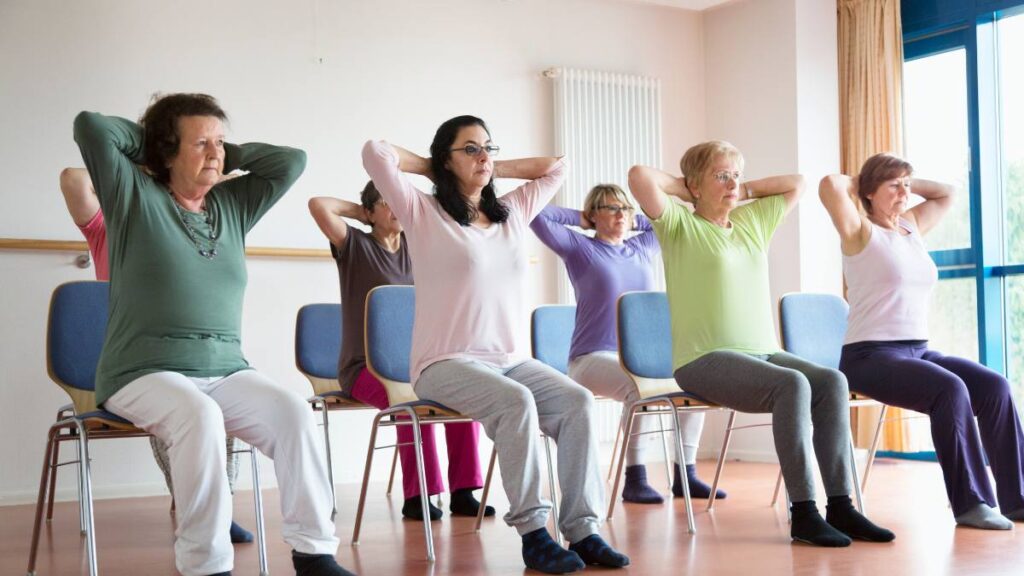
Think of chair Pilates as the kinder, gentler cousin of traditional mat Pilates. It keeps all the core-strengthening, spine-supporting, posture-improving magic—but does it with the support of a chair.
The concept was developed to make Pilates more accessible to those with mobility challenges, chronic pain, or balance issues. Instead of lying on the floor, you perform controlled movements while seated or holding onto the chair for support.
The result? A low-impact, joint-friendly workout that strengthens muscles, enhances breathing, and improves circulation—without the intimidation factor of a gym.
Chair Pilates is perfect for seniors, but also for anyone who spends long hours seated (hello, desk warriors!) or is easing into exercise after a break. Plus, all you need is a sturdy chair and a few minutes of your day.
Why Seniors Are Loving It – Balance Without The Falls
One of the top concerns among older adults is balance—and for good reason. A simple fall can lead to months of recovery or long-term mobility changes. Chair Pilates is designed with fall prevention in mind.
Movements often focus on ankle mobility, core strength, and proprioception (your body’s sense of position in space). These elements play a crucial role in keeping you upright, steady, and confident in daily movements like getting out of bed or stepping off a curb.
Even better? Because many exercises are seated or use the chair as a stabilizer, you can build this balance safely. No need to fear a wobbly yoga pose or a fast-paced aerobic routine—just calm, steady progress toward a more grounded you.
It’s A Workout—But Doesn’t Feel Like One
Let’s be honest: “exercise” can be a scary word, especially when it conjures up images of sweating it out in a gym. But chair Pilates flips that script.
The beauty of Pilates lies in its gentle, mindful movements. You might start with a simple seated twist to wake up your spine, add leg lifts to engage your core, or try arm circles to improve shoulder mobility.
Most seniors report that the sessions feel more like stretching or light movement than a workout—but don’t be fooled. Your muscles are working, and the results show in better posture, less stiffness, and even improved mood.
Bonus? No special clothing, no equipment (besides maybe a resistance band), and you can do it in your living room—slippers included.
Core Strength Isn’t Just About Abs (It’s About Independence)
When we think “core strength,” washboard abs might come to mind. But in the world of senior wellness, core means something far more practical: the ability to get out of a chair, walk confidently, and reduce your risk of back pain.
Chair Pilates focuses heavily on core engagement, often through seated marches, toe taps, and pelvic tilts. These movements activate not just your abs, but also your hips, lower back, and pelvic floor—key players in maintaining mobility and independence.
Building a strong core can make everyday activities easier, whether it’s picking up a grandchild, vacuuming the hallway, or standing in line at the pharmacy without discomfort. It’s not about aesthetics—it’s about ability.
Read Also: How Pilates Can Help With Back Pain?
Flexibility Without Floor Work? Yes, Please.
Many seniors avoid flexibility training because it often requires kneeling or lying on the ground—positions that can be hard to get into (and harder to get out of). That’s where chair Pilates shines.
With a few simple seated stretches, you can increase the flexibility of your spine, hips, shoulders, and hamstrings.
For example, a seated forward fold helps release tension in the lower back and legs, while a gentle side bend can wake up the obliques and improve torso rotation.
Over time, consistent practice can help you reach for objects on a high shelf, tie your shoes with ease, and reduce stiffness after long periods of sitting. Flexibility isn’t just a yoga buzzword—it’s a daily-life superpower, especially as we age.
Mental Health Matters – Move Your Mood
Chair Pilates isn’t just about building a better body—it also boosts brain health and emotional well-being.
Gentle movement combined with mindful breathing helps reduce stress, calm the nervous system, and even improve sleep quality.
Plus, the sense of accomplishment after completing a session can lift your spirits and reduce feelings of helplessness that sometimes accompany aging or chronic illness.
Studies show that regular physical activity—including low-impact forms like Pilates—can decrease symptoms of anxiety and depression in older adults.
Some practitioners even call it “moving meditation.” And we all know that a calm mind leads to better decisions, healthier habits, and a more joyful daily life.
So yes, sitting in a chair and doing slow, deliberate movements can be a legit mood booster—and a prescription-free one at that.
Read Also: Best Pilates Moves For Anxiety Relief
No Equipment? No Problem.
One of the best things about chair Pilates is how low-maintenance it is. You don’t need fancy machines, studio memberships, or piles of props. All you need is a sturdy chair—preferably one without arms, with a flat seat and no wheels.
That said, a few simple tools can enhance your practice and keep things interesting:
- Resistance bands – Great for building strength in the arms and legs without heavy weights.
- Small Pilates ball – Perfect for adding core activation during seated squeezes or between-the-knee presses.
- Yoga block or cushion – Offers extra support for posture or foot elevation.
These items are affordable, portable, and easy to find online. (If you’re shopping, look for sets labeled “senior-friendly” or “gentle resistance.”)
Perfect For Post-Surgery Or Joint Issues
Recovering from surgery? Dealing with arthritis or joint stiffness? Chair Pilates can be your safe return to movement.
Because it avoids weight-bearing strain and allows for modifications, chair Pilates is ideal for people managing osteoarthritis, knee replacements, or hip surgeries.
Movements can be adapted to your range of motion, and most routines focus on alignment and control rather than speed or intensity.
It’s also a great way to stay active without aggravating chronic pain. Many physical therapists now recommend seated Pilates as part of post-rehabilitation routines for seniors who want to maintain strength but aren’t ready for traditional exercise.
Of course, it’s always wise to get your doctor’s OK before starting anything new—but once cleared, chair Pilates can feel like a gentle gateway back to movement and confidence.
Read Also: Can You Do Reformer Pilates While Pregnant?
Short On Time? Even 10 Minutes Makes A Difference
Think you need an hour to get results? Think again.
One of the best-kept secrets of chair Pilates is how effective it can be in just 10–15 minutes. A brief session of core work, leg activation, and stretching can increase circulation, reduce stiffness, and give your energy a noticeable boost.
These bite-sized routines are perfect for busy mornings, mid-afternoon slumps, or winding down before bed. And because they’re gentle, you can even do multiple short sessions throughout the day.
Tip: Set a reminder to stand up and move every hour—then sneak in 5 minutes of seated leg lifts, arm pulses, or deep breathing at your chair. Small steps, big gains.
Group Classes Or Home Alone? You Choose

Chair Pilates is beautifully flexible when it comes to setting. Want social interaction and professional guidance? Look for a local senior center, community wellness group, or online class that offers beginner-friendly chair Pilates.
Prefer the peace and privacy of your home? There are tons of free YouTube channels, DVDs, and apps that guide you through safe, easy routines designed for seniors.
Look for certified instructors with experience in geriatric or therapeutic Pilates for the best results.
Either way, consistency is key. Whether you follow a full-length video or design your own routine using a list of favorite moves, make it a habit. You don’t need a crowd—just commitment.
Read Also: How Many Pilates Classes Per Week Should You Take?
Chair Pilates Can Help With Posture (Say Goodbye To The Hunch)
Let’s talk posture—the silent saboteur of back pain, neck strain, and fatigue. As we age, it’s common to round the shoulders, lean forward, or develop a stooped stance.
Chair Pilates helps reverse this by targeting deep postural muscles like the erector spinae, transverse abdominis, and rhomboids.
Exercises like seated rows, shoulder rolls, and spinal elongation drills encourage you to “sit tall,” realign your spine, and open the chest.
The result? A more upright posture that not only looks better but also makes breathing easier and reduces back strain.
Improved posture also means less pressure on joints, fewer headaches from poor alignment, and greater confidence when walking or standing.
It’s Never Too Late To Start (And Progress Is Real)
If you’ve never tried Pilates—or haven’t exercised in years—it’s easy to think, “Isn’t it too late for me?” The answer is a resounding no.
Chair Pilates is designed for accessibility. It meets you where you are—whether you’re 60, 70, 80, or beyond. Even small gains in strength and mobility can lead to huge improvements in quality of life.
Many seniors notice changes within a few weeks: less stiffness when waking up, better balance in the kitchen, more energy during the day.
Some even use chair Pilates to complement rehab or manage conditions like Parkinson’s, MS, or diabetes (always under medical guidance, of course).
The most important step? Just starting.
Final Thoughts – Chair Pilates For Seniors
Chair Pilates proves that movement doesn’t have to be intense to be meaningful.
With just a chair, a little consistency, and an open mind, you can build strength, balance, and flexibility—right from your living room.
Whether you’re looking to feel steadier on your feet, wake up your core, or simply stay active without joint pain, this gentle practice has your back (literally).
So go ahead—pull up a chair and give it a try. Your body—and future self—will thank you.
Want to get started? Check out beginner-friendly YouTube channels like The Pilates PT or explore resistance bands and Pilates chairs designed specifically for seniors.
Start with just 10 minutes a day and see how you feel!

